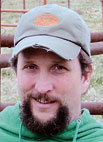
According to the National Agricultural Statistics Service’s 2007 Census of Agriculture, family farms account for almost 96 percent of the 2,204,792 farms in the United States. Heath Shrable and his parents, Carl and Caunita, own one of those family farms.
Located near Gepp, Ark., the Shrable Farm covers over 200 acres. This part of Fulton County has sustained the Shrable family since Carl’s ancestors homesteaded in the 1840s.
Carl said, “My family was more or less subsistence farmers back then, and raised mostly corn, wheat, oats and stuff for themselves. They raised what they ate. Everybody had some cattle. We milked cows and did whatever it took to make a living.”
Heath’s grandpa had some of the first Charolais in their area of the country. They tried a little bit of everything to try and get a satisfactory Charolais cross. They eventually bought a Red Angus bull off of Heath’s Ag teacher. The result was better than any other combination they had tried. Heath said, “We were impressed with the meat that they pack on the carcass, their disposition and their good mothering ability… I can go out there and pet just about any one of them.” Heath currently has four Red Angus herd bulls to service his 18 registered Red Angus cows.
As usual with most farming families, it takes more than a farming income to make the place work. Carl worked for the power company for 22 years and Caunita was a hairdresser for a while. Heath taught Ag in Batesville and is now the Ag teacher at Viola High School.
When he’s teaching about the merits of crossbreeding, Heath uses his personal experience and tells his class, “The Charolais cross shows the continental European cross of breed and that’s what you want. The Continental European is a ‘framier’ cattle. Your English breeds are the shorter cattle but have better muscle and better meat type. When you put the two together, you get the bigger carcass but with the better quality meat all combined into one. The Charolais cross is the easiest way to see it.”
Carl said that all of his cattle are cross-bred. “Mine are yellow, what I call wheat color, half Red Angus and half Charolais. The white cattle don’t sell good – the pure white with a pink nose – it’s too hard to finish them in the feedlots. They don’t grade as good as the Red Angus do,” he said.
It’s a tradition in the Shrable family to pass down the land to successive generations. Even Caunita’s side of the family has a long history in the area. And when the opportunity presented itself, Heath bought land that joined his grandparents’ land. Heath said, “I can’t see not having cattle. I’ve had them my whole life. I’m not getting rich at it, but it’s in my blood.” It’s also “in the blood” of Heath’s sister. Although she doesn’t actually live on the farm, she owns some of the cattle and plays an active part.
The Shrable family’s way of life can be summed up in a wall plaque that hangs on Heath’s dining room wall, surrounded by family pictures: “Family is one of nature’s greatest masterpieces.”







